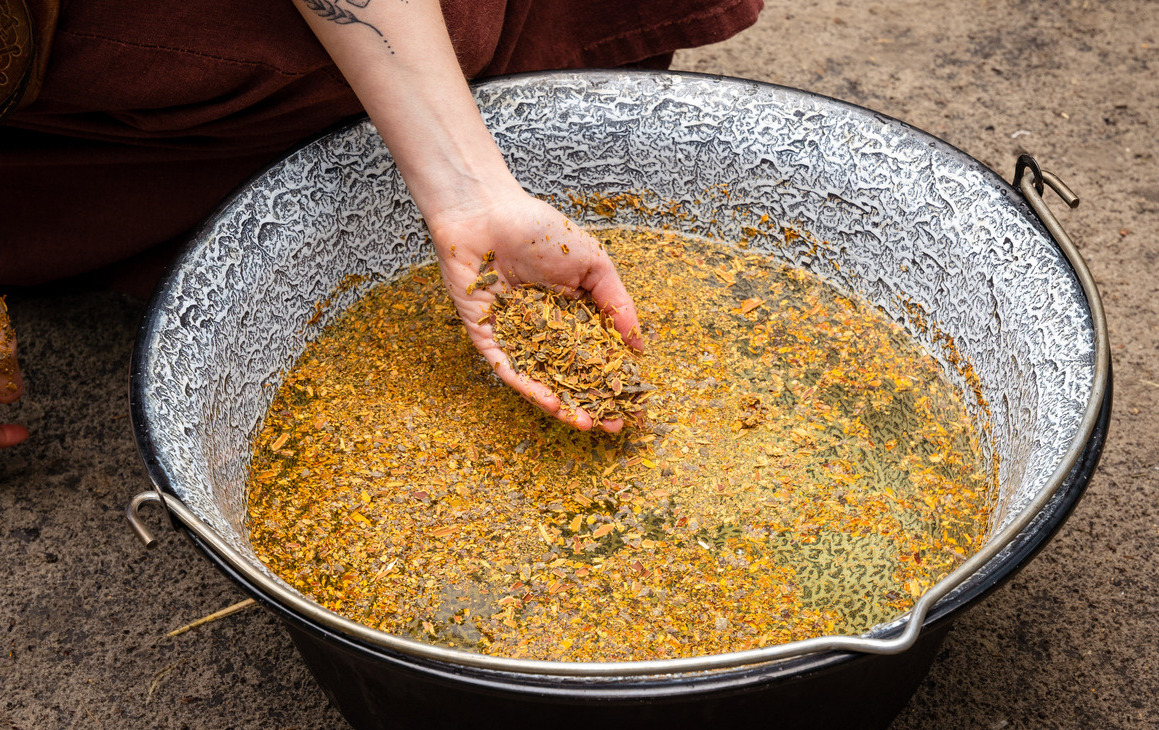In the summer of 2024, we returned to Grodzisko (Polish for settlement or stronghold) in Sopot to experiment with dyeing wool using plant dyes. This is already our second dyeing season at Grodzisko, and we encourage you to check out the results from the previous year.
This season, we focused on achieving intense, warm colours. First, we used oak bark and alder buckthorn bark, followed by madder.
Dyes from Tree Bark
Oak bark produces delicate beige shades on both wool and linen. It does not require pre-mordanting of the wool, as it naturally contains tannins that act as a mordant, helping the dye bind to the fibres. This makes the dyeing process simpler, and the resulting colours are long-lasting and resistant to fading.
Our second dye, alder buckthorn, is a shrub commonly found in forests and thickets across Poland. It has small leaves and dark, pea-sized fruits. However, its bark is the most valuable part, possessing both medicinal and dyeing properties. Dried bark alone yields a strong, intense yellow pigment. When soda (such as the one used in cooking) is added, the dye bath becomes alkaline, shifting the colour towards orange and pink. We were particularly enchanted by the beautiful honey shade it produced on wool from Koniaków, which Ania uses for nalbinding.
From our observations, the less processed the wool, the better it absorbs colour. In this context, we can imagine that hundreds of years ago, when wool was not subjected to mechanical and chemical treatments, not only professional but home dyers could achieve rich, vibrant colours.





Oranges Don’t Like Acid
Interestingly, we discovered that yarns and fabrics dyed with alder buckthorn bark and soda act as an indicator of acid rain! When it started to rain, the orange dye changed back to yellow in the spots where raindrops had fallen. At home, we conducted another experiment: we dipped an orange-dyed piece of silk into water with added vinegar. It instantly turned yellow! Therefore, we primarily recommend alder buckthorn bark for obtaining yellow, as it remains stable even in an acidic environment.
Trusty Old Madder
In the next stages of dyeing at Grodzisko, we used our well-known dyer’s madder (Rubia tinctorum), purchased from Dzikie Barwy who are specialists in plant-based dyes.
Dyer’s madder was once widespread in Europe and has been used for dyeing since antiquity. Today, you might find its wild relatives in forests, though they contain less dye pigment. We opted for madder powder to avoid fishing out plant fragments from the dye bath.
Dyeing with madder is quite simple and intuitive. Pre-soaked wool is placed into the dye pot and simmered over low heat for at least an hour. Then, it needs to be rinsed several times to remove any remaining dye particles. Madder is a strong dye, resistant to fading and washing out. We achieved a range of reds, from deep purples to warm orange-reds.
And in the background—conversations, jokes, fence repairs—just everyday life at Grodzisko.







You must be logged in to post a comment.